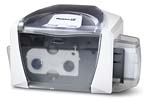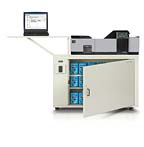As Printers Diverge

Growth in such price-driven ID card systems for small companies, K-12 schools, health clubs and loyalty applications has been fueled by the Internet and its convenience in researching and purchasing products, contends Sharon Steinhoff Smith of Fargo Electronics, Eden Prairie, Minn. By unofficial count, she says, there are more than 20 card printer manufacturers worldwide, the majority of which are focused on entry-level products.
As card functionality, ease of use and basic security increase at the entry level through new technologies such as inkjet, organizations without current card programs will get on board.
Less competition is in place at the high-end of the market, namely government and large corporate applications. High security multi-function applications demand more complex solutions. For example, the growing use of smart cards has increased the demand for reverse image card printers. In this design, images print in reverse onto clear film, which is then fused into the surface of a blank card through heat and pressure.
Securing the process
Card printer/encoders are just part of higher security ID card printers, according to Steinhoff Smith. System integrators and end users are both looking for better ways to secure the card issuance process. Securing the card issuance process means identifying and eliminating any vulnerabilities in the production of ID cards.Here is a sampling of questions that can help the integrator-end user team assess potential vulnerabilities:
Who has access to the printing equipment, at what times and at what authority levels? An area of vulnerability is the threat of someone creating false credentials within a legitimate card identity program. Software is now available with a printer access feature that offers security managers the ability to set passwords that are required to make the printer/encoder operational. This function reduces both internal and external threats of fraud or misuse by automatically disabling a stolen or illegitimately accessed printer

Does the card itself contain security elements such as customized holograms, morphing images, fine line design, covert printing and other visual security features that will make the cards difficult to fraudulently copy? Customized elements like these not only add security to the client’s card, but also add a proprietary element to an integrator’s offering.
The key to developing a secure card issuance program is to add layers of security that cumulatively become a deterrent for potential counterfeiters. The result is a more secure and happy client and a more trusted and profitable integrator

Sidebar: Member Cards Add Credibility
While ID card printer use diverges along card production volume and level of security, it also can branch out as security needs blend into business and financial needs.A case in point: The Federation of Employers and Workers of America (FEWA), a non-profit, Texas-based association created to help companies obtain a legal alien workforce in service industries under the Federal H2B worker program, recognized the need for a durable membership card that would identify its worker members. The non-profit organization decided to print its cards in-house so it could create them on demand.
FEWA provides legal information to its members relating to the H2B program and immigration matters. It also helps members prepare pre-printed H2B program forms and offers a wide variety of other support services to its member workers.
“We have about seven thousand worker members and we wanted a card that would identify them with their name and what company they are working for here in the U.S.,” says Donna Payne, business manager for FEWA. “We may eventually use smart cards and encode all of our members’ pertinent information right on the card.”
FEWA chose a Zebra (Zebra Card Printer Solutions, Cararillo, Calif.) P420i printer. It’s a stand-alone, dual-sided color printer and the printer ribbon synchronizes automatically, eliminating the need for operator intervention. “Three of our staff members who are trained on the printer have printed about five thousand cards in the past year,” Payne reports.
The FEWA membership cards include the member’s name, the company they work for and the FEWA Web site address on the back. It sports the FEWA letterhead design. Under the H2B program, workers can only be employed in the United States for 10 months at a time. They must leave the country and then reapply for the program. FEWA members who rejoin are issued a new membership card each time. Payne concludes, “It’s another form of identification for him and it makes it more desirable to be a FEWA member.”
Looking for a reprint of this article?
From high-res PDFs to custom plaques, order your copy today!


